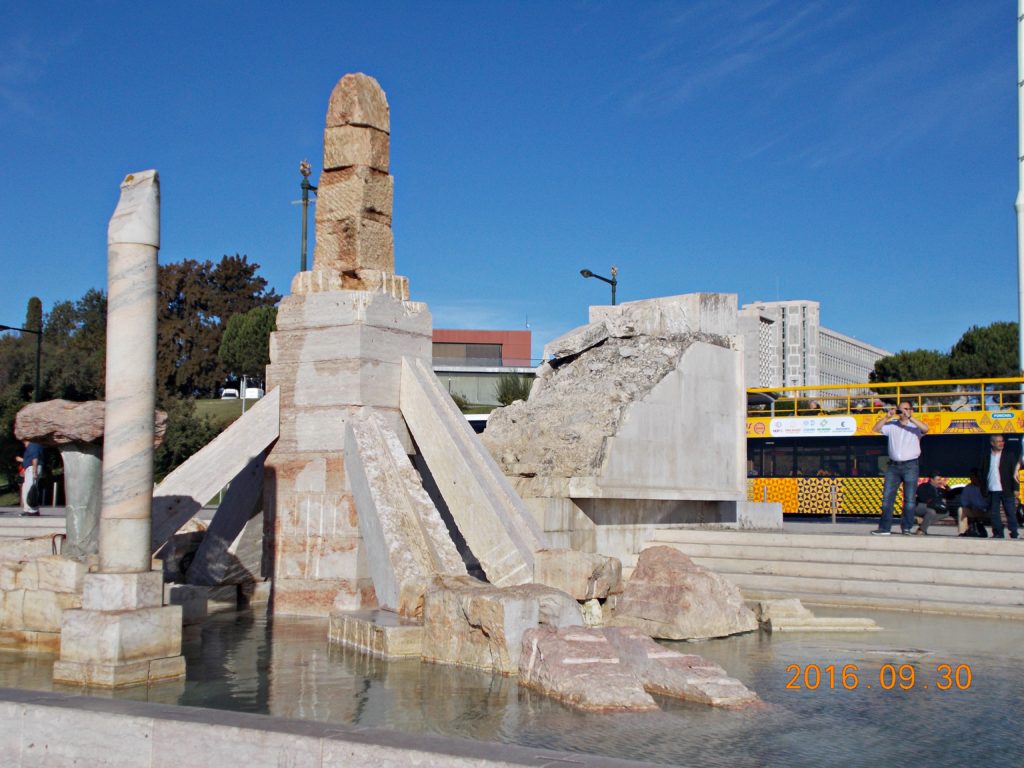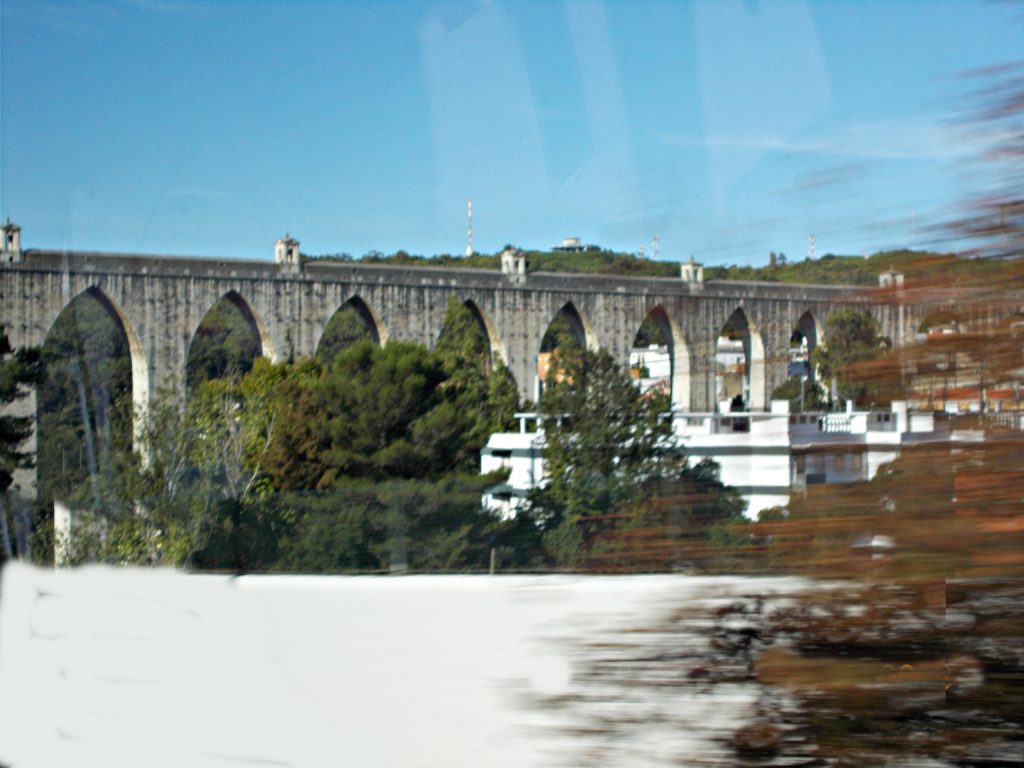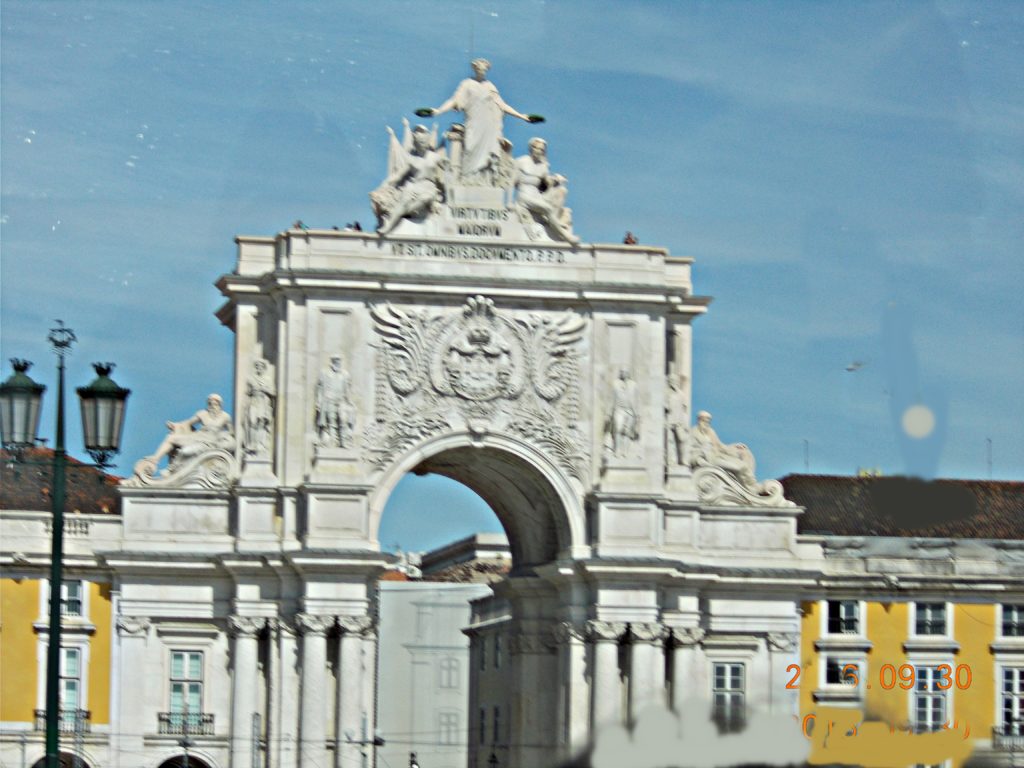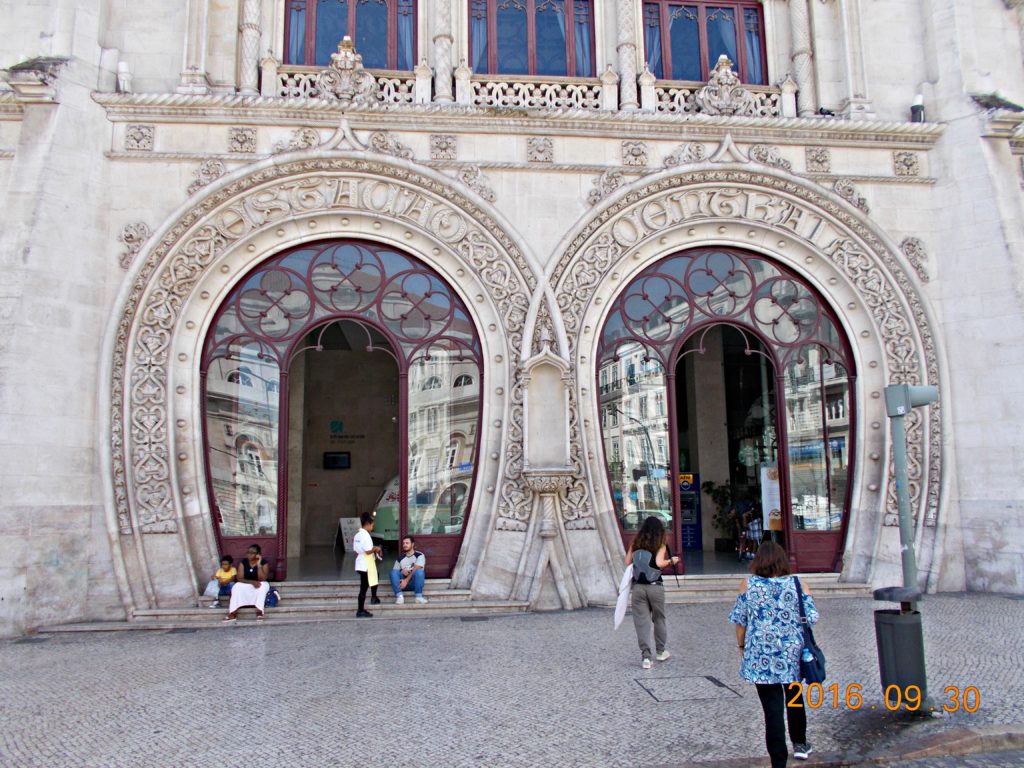Iberian Adventure – Page 14
Funiculì, Funiculà
Here we are in Lisbon for Day 13. We start with a bus tour of the city:

First Stop: This is the Park Eduard VII. It is the biggest park in central Lisbon.The park was named after Britain’s king, Edward II, who came to the city on a state visit in 1903 to strengthen Anglo-Portuguese relations. Parque Eduardo VII features mosaic patterned walkways that stretch uphill throughout the whole park.
The same river we saw in Toledo: The Tagus. It empties into the Atlantic Ocean near here.

At the top of the park is this monument. It is the “25 of April Monument” by João Cutileiro
It in a small esplanade with four large pillars and a fountain that commemorates the Revolution of 1974. This spot also has a gorgeous view of the Tagus river and the city. The fountain kinda looks like a phallus…but maybe my mind is in the gutter today. You can judge for yourself.

Here is another “25th of April” monument:
The Carnation Revolution also referred to as the “25th of April” was initially a Military Coup in 1974 which overthrew the authoritarian regime of the Estado Novo
The revolution started as a military coup organized by the Armed forces composed of military officers who opposed the regime, but the movement was soon coupled with an unanticipated and popular campaign of civil resistance. This movement would lead to the fall of the Estado Novo and the withdrawal of Portugal from its African Colonies.
The name “Carnation Revolution” comes from the fact that almost no shots were fired and that when the population took to the streets to celebrate the end of the dictatorship and war in the colonies, carnations were put into the muzzles of rifles and on the uniforms of the army men. In Portugal, 25 April is a national holiday, known as Freedom Day to celebrate the event.

From the park, we headed towards the Tagus River. We passed The “Aqueduct of the Free Waters”). It is a historic aqueduct It is one of the most remarkable examples of 18th-century Portuguese engineering. The main course of the aqueduct covers 11 miles, but the whole network of canals extends through nearly 36 miles.
The city of Lisbon has always suffered from the lack of drinking water, and King John V in 1746 decided to build an aqueduct to bring water from sources in the parish of Canecas, in the modern municipality of Odiveles. The project was paid for by a special sales tax on beef, olive oil wine, and other products.
I had thought it might have been an ancient Roman aqueduct. Wrong!

This is Jerónimos Monastery and Church of Santa Maria of Belem on the Tagus River.
The Jeronimos Monastery is the most impressive symbol of Portugal’s power and wealth during the Age of Discovery. King Manuel I built it in 1502 on the site of a hermitage founded by Prince Henry the Navigator, where Vasco da Gama and his crew spent their last night in Portugal in prayer before leaving for India.
It was built to commemorate Vasco Da Gama’s voyage and to give thanks to the Virgin Mary for its success. Vasco da Gama’s tomb was placed inside by the entrance.

Here’s the old boy now!

This is not “the old boy” This is Juanjo with a box of Pastries de Belem. These are special pastries made only here near the church. He shared them with us. They were delicious. Kind of like an egg custard tart.

This is what they looked like. We saw several similar pastries around town, but not the same ones – copies…
5 FACTS ABOUT THE BELÉM PASTRIES
1. The confection of Belém’s Pastries began in 1837 and the recipe remains exactly the same to this day.
No High Fructose corn syrup?
2. The Belém Pastries are baked in the “Secret Shop”.
Don’t tell anyone – they’re made by Hostess?
3. Belém Pastries and Custard Tarts are not the same thing.
Try to tell the difference. Maybe price is the difference.
4. Every day, about 20,000 pastries are made and sold.
Enough to go around Portugal – Twice
5. “A bride who eats a pastry will never take off her ring.”
Her fingers would be too fat!
I’ll let you decide what are the “Fake Fact”…

This is Torre de Belém on the Tagus.
Standing on the waterfront at Belem near the mouth of the River Tagus is the Torre de Belém, arguably the most iconic symbol of Lisbon. Originally conceived as a lighthouse, the tower was eventually built as a defensive fortress on the orders of King Manuel I
Kids have endless fun playing hide and seek amongst the parapets, or scampering up and down the narrow spiral staircases. The rest of us, meanwhile, can contemplate the achievements of Portugal’s bravest navigators who departed near this historic landmark to chart unknown lands 500 years ago.
This is not a monument to Columbus, as many think. It is a monument to Prince Henry the Navigator He was an important figure in 15th-century Portuguese politics and in the early days of the Portuguese Empire.
Through his administrative direction, he is regarded as the main initiator of what would be known as the Age of Discoveries. and was responsible for the early development of Portuguese exploration and maritime trade with other continents through the systematic exploration of Western Africa, the islands of the Atlantic Ocean, and the search for new routes.
He’s on the top left. All those he colonized and/or enslaved are below him.
After spending time at these memorials, we headed back down town to look at the commercial water front.
We didn’t actually visit this monument, but we saw it in the distance. It deserves mentioning.

This is the Sanctuary of Christ the King. It is the Catholic monument and shrine dedicated to the Sacred Heart oh Jesus overlooking the city of Lisbon situated in across the Tagus River in Alamada. It was inspired by the Christ the Redeemer statue ofRio de Janiero, after the Cardinal Patriarch of Lisbon visited that monument.
The project was inaugurated on 17 May 1959, while Portugal was ruled by the authoritarian President Salazar who gave his final permission for the project. The giant statue in cement was erected to express gratitude because the Portuguese were spared the effects of World War II.
For comparison: Christ the King is 60 ft tall (360 ft.with base). Christ the Redeemer in Rio is 130 feet tall. Christ the King in Świebodzin, Poland is 108 ft (with crown it’s 117.8 ft).

The Rua Augusta Arch is a stone Triumphal arch and historical building and visitors center on the Praca de Comercio.
It was built to commemorate the city’s reconstruction after the 1755 earthquake. It has six columns (11 m high) and is adorned with statues of various historical figures. Significant height from the arch crown to the cornice imparts an appearance of heaviness to the structure. The associated space is filled with the coat of arms of Portugal.

The Tagus river is navigable and Lisbon is now a port of call for cruise ships.
 We returned to the hotel and Juanjo got a group together for a walk. We passed the main Rail Station. The station was commissioned by the Portuguese Royal Railway Company and was designed between 1886 and 1887 by Portuguese architect José Luís Monteiro. It was built in one of the most important squares of Lisbon, the Rossio and connected the city to the region of Sintra.
We returned to the hotel and Juanjo got a group together for a walk. We passed the main Rail Station. The station was commissioned by the Portuguese Royal Railway Company and was designed between 1886 and 1887 by Portuguese architect José Luís Monteiro. It was built in one of the most important squares of Lisbon, the Rossio and connected the city to the region of Sintra.
 …a funicular stop.
…a funicular stop.

We fully occupied the funicular and one of our Korean tour mates led us in a rendition of “funiculì, funiculà!” (i think that’s what we sang. It was a bit noisy so I’m not sure. The ride took us to a nice Lisbon viewpoint.

This was our view. We could see our hotel (smack in the center) and St. Georges castle on the hill top beyond. More on the castle later.

On the way back to the hotel, Juanjo treated us (again) to some roasted chestnuts (castañas). I’m not sure I liked them.
That evening our entire group met in the penthouse dining room at the hotel for a nice “last supper”. Many thanks to GCT!
That was it for me on the evening of Day 13.
Lights out!
Go To Page 15


















